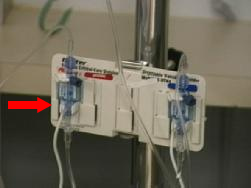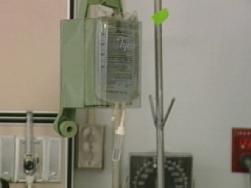|
PRESSURE MONITORING In the critical care unit, we measure many different pressures within the body to help monitor the patient's condition. The most common type pressure monitoring is arterial pressure monitoring. The pressure in the right side of the heart, called CVP, is also measured frequently. We often use the term "Hemodynamic Monitoring". "Hemo" pertains to blood, and "dynamic" refers to flow or movement. Anything that is monitored that evaluates the movement of blood, the heart's performance or the pressures within the blood vessels is considered a form of Hemodynamic Monitoring. Pressures in the heart and blood vessels change during each beat or cycle of the heart (called the cardiac cycle). Systole is the portion of the cycle when the heart is contracting and pumping blood. As the heart contracts, blood is forced into the blood vessels causing the pressures to rise. During diastole, the heart is relaxing and filling. The pressure in the heart and blood vessels falls during this relaxation phase. This cyclic change in the pressures with each cardiac cycle produce pressure waves. A pressure wave is a "map" of the rises and falls in a pressure. When you have your blood pressure taken in your doctor's office, it is reported as a high number over a low number. These are the pressures in the artery during systole and diastole. When we measure pressures with electronic devices, we will usually display 3 numerical pressures on the monitor. The top number is the pressure during systole or pumping, the bottom number is the pressure during relaxation or diastole and the side number is the average pressure during the entire cycle (called the mean pressure). All pressures are measured the same way in the critical care unit. An infusion is connected to a pressurized box to prevent blood from backing up the catheter. The pressurized box is called a TycosTM. Fluid is infused into the pressurized line at a very slow rate of speed, and a special in-line device called a transducer detects the pressure that is transmitted through the fluid filled tubing. The waveform is then converted to a waveform on the bedside monitor. The principles of pressure monitoring are the same for all pressures measured. You may come to the bedside and find a pressure waveform that is flat. This does not mean there is anything wrong. It may mean that the catheter is kinked and unable to detect the waveform (a common problem in arterial lines when patients bend their wrists), or the line might be temporarily turned off to the monitor in order to use it for intravenous therapy. We have several different types of alarms that will notify us of any change in the pressure. You will often hear an alarm when you are at the bedside. Many of these alarms are due to patient movement and do not indicate a problem with the patient. You may feel anxious the first few times you hear the alarms at the bedside. A nurse is always close by and can answer any questions you have about the monitors. |
Image 1: Transducer that detects the pressure waveform and converts it to a signal on the monitor. The flush device (arrow) maintains the pressue while controlling the flow rate. |
|
Image 4: Box used to pressurize infusion fluids (called a "TycosTM"). |
|
|
|
|
|
|
|
|
|
Our masking guidelines have been updated. Visit the Patient and Visitor Masking Guidelines page for more information.





